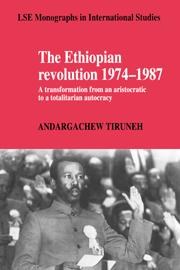 The Ethiopian Revolution 1974–1987
The Ethiopian Revolution 1974–1987 Book contents
- Frontmatter
- Contents
- List of maps and tables
- Acknowledgements
- List of abbreviations
- Map 1 The Horn of Africa
- Map 2 Administrative divisions
- 1 The background to the emergence of the structural crisis
- PART I THE COLLAPSE OF THE OLD-STATE (JANUARY–NOVEMBER 1974)
- PART II THE FORMATIVE YEARS OF THE POST-REVOLUTIONARY ORDER (DECEMBER 1974–FEBRUARY 1977)
- PART III CONSOLIDATION OF POWER (FEBRUARY 1977–SEPTEMBER 1987)
- 8 The elimination of internal and external threats to Mengistu's power
- 9 The formation of the Workers' Party of Ethiopia
- 10 The formalization of power through the 1987 constitution: ‘organizational operation’ in action
- 11 Conclusion
- Postscript
- Appendix: chronology of events
- Notes
- Bibliography
- Index
- LSE MONOGRAPHS IN INTERNATIONAL STUDIES
9 - The formation of the Workers' Party of Ethiopia
Published online by Cambridge University Press: 18 December 2009
- Frontmatter
- Contents
- List of maps and tables
- Acknowledgements
- List of abbreviations
- Map 1 The Horn of Africa
- Map 2 Administrative divisions
- 1 The background to the emergence of the structural crisis
- PART I THE COLLAPSE OF THE OLD-STATE (JANUARY–NOVEMBER 1974)
- PART II THE FORMATIVE YEARS OF THE POST-REVOLUTIONARY ORDER (DECEMBER 1974–FEBRUARY 1977)
- PART III CONSOLIDATION OF POWER (FEBRUARY 1977–SEPTEMBER 1987)
- 8 The elimination of internal and external threats to Mengistu's power
- 9 The formation of the Workers' Party of Ethiopia
- 10 The formalization of power through the 1987 constitution: ‘organizational operation’ in action
- 11 Conclusion
- Postscript
- Appendix: chronology of events
- Notes
- Bibliography
- Index
- LSE MONOGRAPHS IN INTERNATIONAL STUDIES
Summary
Ethiopia is one of the few African countries that survived without being colonized by the Western powers. This fact, more than any other perhaps, kept her oblivious of Western political processes, notably the process concerned with political parties. An exception to this was Eritrea, which after having been under Italian colonial administration for about fifty years, came under British administration from 1941 to 1952 as an enemy-occupied territory. In the 1940s a number of political organizations sprang up around the question of the disposal of the territory. It is arguable whether those political organizations were ‘parties’, since they did not have a programme on questions other than the disposal of Eritrea; at any rate, with the federation of Eritrea with Ethiopia in 1952 by a decision of the UN General Assembly, the political organizations withered and died.
The last constitution of Haile Selassie's government, which was issued in 1955, provided that ‘every Ethiopian subject has the right to engage in any occupation and, to that end, to form or join associations in accordance with the law’. This was the only provision of the constitution that could arguably be interpreted to allow the right to form political organizations. Nevertheless, it strongly implies that the formation of an association has to be related to occupation, and hence, excludes the formation of political organizations. In reality too, there was never any public demand to form political organizations, and the general assumption was that the legal right to do so did not exist.
- Type
- Chapter
- Information
- The Ethiopian Revolution 1974–1987A Transformation from an Aristocratic to a Totalitarian Autocracy, pp. 227 - 264Publisher: Cambridge University PressPrint publication year: 1993
